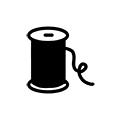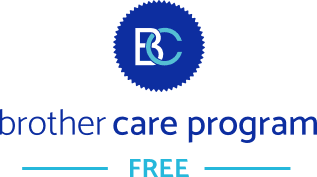Express deliveries are temporarily unavailable. LEARN MORE



Discover our user-friendly, reliable and highly technical sewing machines. Whether you are a beginner or an expert in sewing, no matter how easy or complex your project is, we have what you need.


Price
Model # : JX2417
JX2417
Lightweight, yet full-sized and affordable, this mechanical sewing machine offers all the best features and stitches for everyday sewing and mending. With 17 utility and decorative stitches, 4 included presser feet and a variety of other accessories, your general sewing has never been easier. View Details

Built-in stitches
17 stitches

Quick-set bobbin
Quick-set bobbin

Included accessory feet
Zigzag foot, zipper foot, buttonhole foot, button sewing foot

Buttonhole
1 x 4-step

Easy threading
Built-in easy threading system
Model # : XS6070
XS6070
Affordable, lightweight and easy-to-use, Brother s XS6070 computerized sewing machine is loaded with professional features and comes with a variety of 7 sewing feet and much more making it a perfect choice for basic mending, garment construction and heirloom sewing. View Details

Quick-set bobbin
Quick-set bobbin

Easy threading
Easy threading

Built-in stitches
70

Included presser feet
7

Buttonhole
7 one-step
Model # : CE6080T
CE6080T
Perfect for basic mending, garment construction and heirloom sewing, the Brother CE6080T computerized sewing machine offers many professional features and comes with 7 sewing feet: zig-zag, blind stitch, button sewing, buttonhole, monogramming, overcasting and zipper. View Details

Quick-set bobbin
Quick-set bobbin

Easy threading
Easy threading

Built-in stitches
60

Included accessory feet
7

Buttonhole
7 one-step
Model # : CP2410
CP2410
Perfect for new or seasoned sewers, alike, the CP2410 is a smart choice for all your sewing and quilting projects. View Details

Built-in stitches
240

Built-in fonts
2

Automatic needle threading
Advanced needle threading

Extension table
Extension table

Buttonhole
8 x 1-step
Model # : JX1420
JX1420
User-friendly and packed with features, the JX1420 sewing machine has everything you need in a compact and lightweight package. With 14 utility and decorative stitches, 4 included presser feet and a variety of other great accessories, your general sewing has never been easier. View Details

Built-in stitches
14

Included presser feet
4

Quick-set bobbin
Quick-set bobbin
Model # : LX3850
LX3850
Versatile, dependable and easy to use, the LX3850 is great for sewing and quilting hobbyists. View Details

Built-in stitches
37 stitches

Automatic needle-threading
Automatic needle-threading

Extension table
Extension table

Quick-set bobbin
Quick-Set bobbin

Buttonhole
1-step buttonhole
Model # : SQ9130
SQ9130
This 130-stitch sewing & quilting machine has all the best features of high-end models, but without the expensive price tag! View Details

Built-in stitches
130 stitches

Built-in fonts
1 font

Automatic needle threading
Advanced needle threading

Extension table
Extension table

Buttonhole
8 x 1-step buttonholes
Model # : HC3010
HC3010
The lightweight and portable HC3010 is your go-to machine for sewing classes. View Details

Built-in stitches
130 stitches

Built-in fonts
1 font

Automatic needle threading
Advanced needle threading

Extension table
Extension table

Buttonhole
8 x 1-step buttonholes
Model # : SC9500
SC9500
With 90 built-in utility, decorative and heirloom stitches, the SC9500 is the ideal machine for embellishing virtually everything from clothing to home décor items and for creating unique quilt designs. View Details

Built-in stitches
90 stitches

Built-in fonts
1 font

Automatic needle-threading
Advanced needle-threading

Extension table
Extension table

Buttonhole
8 x 1-step buttonholes
Model # : CE6085T
CE6085T
Perfect for basic sewing and mending, the Brother CE6085T computerized sewing machine offers many professional features and comes with 10 sewing feet: zig-zag, blind stitch, button sewing, buttonhole, monogramming, overcasting, zipper, 1/4 inch piercing foot, quilting foot and walking foot. View Details

Quick-set bobbin
Quick-set bobbin

Easy threading
Easy threading

Built-in stitches
60

Included accessory feet
9

Buttonhole
5 one-step
Model # : BM3730
BM3730
With everything you need for all your sewing and quilting projects, this easy-to-use, flexible machine is a great choice for beginners and seasoned sewers alike! View Details
Model # : LB7950
LB7950
The Brother LB7950 is the perfect machine for expanding your creativity with embroidery. Enjoy the benefits of a generous 6.4" x 4" workspace, a maximum 4" x 4" embroidery area, plus the 3.7" LCD display, which allows for easy on-screen editing. View Details

Easy threading
Easy sewing and embroidery

Wireless
Wireless LAN enabled.

Digitizing capability
3.7" LCD display

Workspace
Lots of room to work.

Accessories
Included Accessories
Model # : BM2800
BM2800
The 63-stitch-function Brother BM2800 sewing machine features an easy automatic 1-step buttonholer with stitch balance control for perfectly uniform buttonholes, every time. View Details

Built-in stitches
27 stitches

Automatic needle-threading
Automatic needle-threading

Quick-set bobbin
Quick-Set bobbin

Buttonhole
1-step buttonhole

Included accessory feet
6 feet
Model # : HC7140
HC7140
The versatile, user-friendly HC7140 features 140 sewing and quilting stitches, 9 accessory feet, a detachable wide table for larger projects and an extra-large LCD screen for easy viewing. View Details

Built-in stitches
140 stitches

Built-in fonts
1 font

Automatic needle threading
Advanced needle threading

Extension table
Extension table

Buttonhole
8 x 1-step buttonholes
Model # : CE1010
CE1010
Brother CE1010 Computerized Sewing Machine is reliable, affordable and user-friendly. Great for basic mending and garment construction, it offers 110 built-in stitches, 8 1-step buttonholes, LCD stitch selection, LED-lighting, advanced needle threading, and so much more. View Details

Quick-set bobbin
Quick-set bobbin

Easy threading
Easy threading

Built-in stitches
110

Included presser feet
6

Buttonhole
8 one-step
Choosing the right sewing machine takes into consideration several key factors to ensure it meets your specific needs and skill level.
It is essential to check the types of stitches that the sewing machine you're eyeing can perform.
Some sewing machines offer automatic features and options that simplify usage and make the sewing experience more enjoyable and efficient:
When choosing a sewing machine, included accessories can be an additional advantage. Common accessories you will generally need include:
For beginners, a sewing machine should include user-friendly controls, automatic features like needle threading and buttonholes, and a variety of built-in stitches. A mechanical sewing machine, simple and durable, is typically ideal.
The Brother JX2417 Mechanical Sewing Machine is especially suitable for beginners, offering essential functionalities to make learning sewing easy and fun, while being an affordable machine.
The main difference between computerized and mechanical sewing machines lies in their operation and features. Computerized sewing machines are equipped with a microprocessor, allowing them to offer advanced features such as automatic needle threading, programmable stitch patterns, and digital displays for precise control. Mechanical sewing machines, on the other hand, rely on manual controls and mechanical parts to perform basic sewing functions, making them simpler and often more durable but with fewer advanced features.
It's important to note that every sewing machine is different, and it's best to consult your machine's manual for specific instructions. However, here are some general steps to follow when using a sewing machine. Start by threading the machine following the instructions in the manual. Wind the bobbin and insert it correctly. Place your fabric under the presser foot and lower the presser foot lever. Select the desired stitch and adjust the stitch length and width if needed. Press the foot pedal or use the start/stop button to begin sewing, guiding the fabric gently and keeping a consistent pace. Practice controlling the speed and experimenting with different stitches. Remember to cut the threads and remove the fabric carefully after sewing. If you need any help, you can use our support resources.
To clean and maintain your sewing machine, start by turning it off and unplugging it. Use a small brush or a soft cloth to remove dust, lint, and debris from the machine's exterior and crevices. Remove the needle plate and bobbin case to clean the bobbin area. Use a lint brush or tweezers to remove lint and stray threads. Oil the machine following the manufacturer's instructions to lubricate moving parts. Replace the needle regularly and keep the machine covered when not in use. Consult your sewing machine's manual for specific cleaning and maintenance instructions.


Access Your Account Dashboard
Sign in here!
Forgot your Password?
Resetting your password is easy!
Enter your email address below. We'll send you an email with a link to reset your password.
Sign up with Brother Canada
Get the latest updates on our products!

Welcome to Brother Canada!
You're shopping from a location where delivery is currently unavailable (Nunavut, Northwest Territories, Yukon).
If you a shipping address in one of the provinces below, please select it to continue with your online purchase.
Otherwise, you can continue browsing to find a retailer, get info about Brother products, contact Customer Care and explore creative projects.
Bienvenue à Brother Canada!
Vous magasinez à partir d'un endroit à l'extérieur de notre territoire de livraison (Nunavut, Territoires du Nord-Ouest, Yukon).
Si votre adresse de livraison se trouve dans l'une des provinces suivantes, veuillez la sélectionner pour poursuivre vos achats en ligne.
Sinon, vous pouvez ignorer cette étape pour trouver un détaillant, vous renseigner sur les produits Brother, communiquer avec le Service à la clientèle et découvrir des projets de création.
 6-month extended warranty.
6-month extended warranty.





 6-month extended warranty.
6-month extended warranty.




 Your product has been registered
Your product has been registered
 6-month extended warranty.
6-month extended warranty.





View the Terms & Conditions of the Brother Care Program. To update your email preferences, visit My Preferences.
Back to My Account Your product has been registered
Your product has been registered
 6-month extended warranty.
6-month extended warranty.





View the Terms & Conditions of the Brother Care Program. To update your email preferences, visit My Preferences.
Back to My Account Your product has been registered
Your product has been registered
 6-month extended warranty
6-month extended warranty





 Your product has been registered
Your product has been registered
 6-month extended warranty.
6-month extended warranty.





 Your product has been registered
Your product has been registered





View the Terms & Conditions of the Brother Care Program. To update your email preferences, visit My Preferences.
Back to My Account Your product has been added to your cart
Your product has been added to your cart
 6-month extended warranty
6-month extended warranty





 Your product has been added to your cart
Your product has been added to your cart
 6-month extended warranty.
6-month extended warranty.





View the Terms & Conditions of the Brother Care Program. To update your email preferences, visit My Preferences.
Continue Shopping Your product has been added to your cart
Your product has been added to your cart





 Your product has been added to your cart
Your product has been added to your cart





View the Terms & Conditions of the Brother Care Program. To update your email preferences, visit My Preferences.
Continue Shopping Your product has been registered
Your product has been registered





Get 30% off Genuine Brother supplies with any printer purchase when you buy now.
Use Promo Code now and save! *
*Promo code can’t be combined with any other promotion.